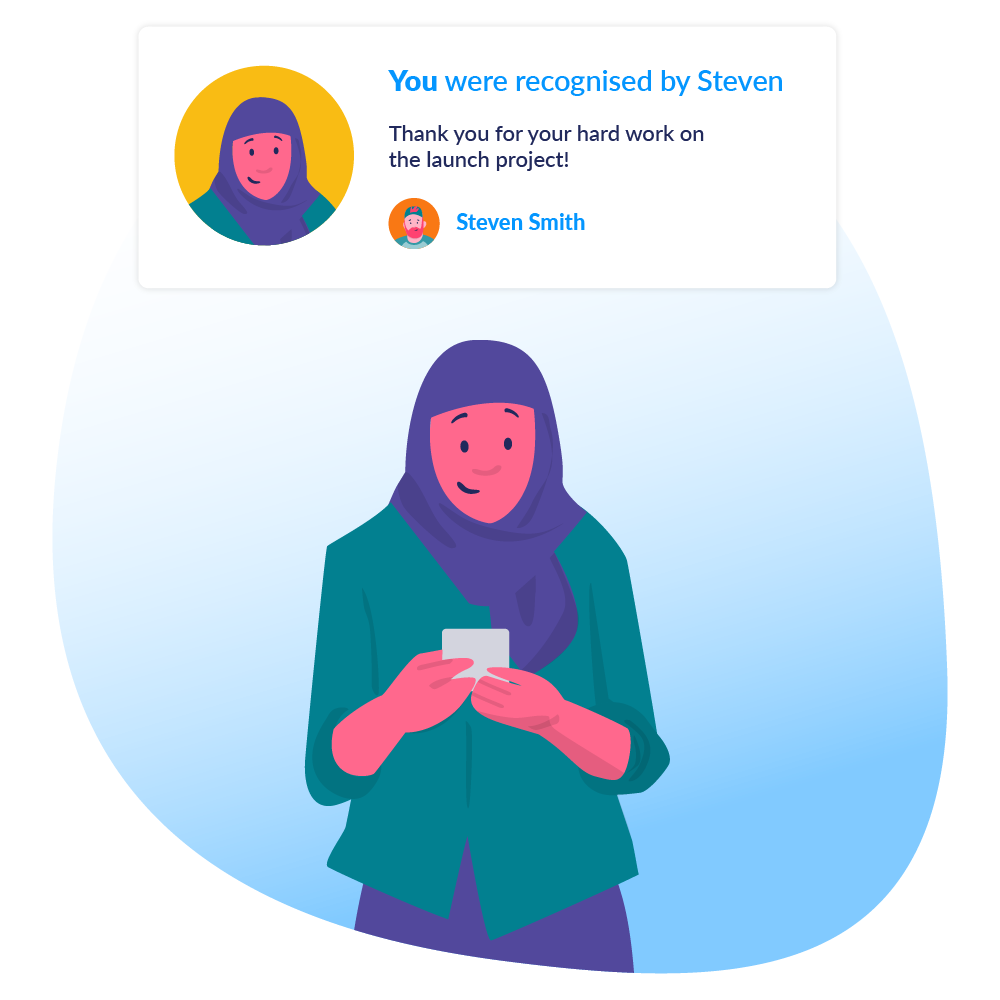What is employee recognition?
Employee recognition is when a company acknowledges its staff for great work. Its goal is to encourage and reinforce behaviour that helps the business reach its goals, or is in line with the business’s values or vision. It can also be a major driving factor in employee attraction and retention.
You'll definitely recognise questions, such as: Are you hard-working? Do you go above and beyond? Are you a great team player? Countless job offers start the same way and set the tone for the rest of your working relationship. We all know that hard work is appreciated — it’s a given — but is it also rewarded and recognised in the right way?
We’re not talking about salary here, but the way your company goes about recognising and rewarding employee effort and exceptional achievements. Oh, and the fact that they dedicate a large part of their daily lives to your business!
In this guide, we’ll dissect what employee recognition is really about. Like why you should celebrate your employees more often and how you go about it.
Why is employee recognition important?
Making employees feel valued comes with a lot of benefits, such as:
- Giving staff a sense of purpose in their work
- Increasing motivation and satisfaction
- Creating a positive workplace environment
- Attracting and retaining talent
Don't underestimate the benefits of good employee recognition. You might think a simple thank you will do once a project or task is completed, but we humans are a lot more complicated than that. We want to receive praise — even if it's within our usual job description. If we don't receive positive feedback in the workplace, we're likely to experience employee burnout.
Many people can't remember the last time their manager congratulated them on a job well done, or gave them a compliment in front of everyone, and staff satisfaction drops as a result. At the same time, a lot of people can't remember when they last gave a peer or even a manager a compliment on their work. We’re all guilty here, but we all have the same needs too.
Many managers focus so much on their business doing well, that they forget that this requires their employees doing well. Receiving regular recognition and praise in a way that’s fair, honest, and genuine is good for our mental health. And ultimately, that helps create a healthy business.

What happens when employees feel unrecognised?
When you start making employee recognition a part of your workplace culture, you'll notice some big differences. If you don't, your business, employees and customers will pay the price.
On an individual level, people will be more motivated and feel like their work is more meaningful (for instance, by implementing an employee incentive scheme.) That leads to a better workplace culture and improved teamwork.
What it will eventually churn out is increased productivity and happier customers. Then, the whole cycle starts again — and it should never stop.
Apart from happier customers, you'll also have happier employees. The line between our personal and professional lives is becoming even thinner, and what we experience in one affects the other. Taking care of your employees will make their lives a little better.
When we receive positive feedback, we’re more inclined to repeat the behaviour that got us that compliment. It’s not a trick to get employees to work overtime by the way — but a way to improve overall well-being across your workforce — which will also affect the health of your business.
Investing in different types of employee recognition can also spark creativity and innovation in your company. What employees need is the confidence to bring new ideas forward. Knowing that they’ll be recognised for taking the initiative — even if the idea doesn't end up being a huge success — could light a fire in them and make them more willing to try new things.
Another element that shouldn't be overlooked is the trust employee recognition builds between employees and managers. Knowing your manager is truly invested in what you do and is happy to point out if something goes right, helps build trust which makes it easier to discuss issues in the workplace.
The last reason you should be investing more time and effort in recognising your team's efforts, is that it leads to lower turnover rates. So if you want to work on employee retention, start by looking at how you’re performing on employee recognition.

The key to successful recognition at work
Recognition might sound easier than it is. It’s not just compliments and cards. But with the right systems in place, it becomes natural and effortless, although it's crucial to understand what successful recognition looks like — and what it isn't.
Recognition should be delivered in a way that is:
- Meaningful: make clear what you’re actually giving recognition for, so the employee can reflect on this and know what they should be proud of.
- Timely: give recognition when it's still relevant. It's never too late for a compliment, but it's better to do it right after a project than leaving it until the Christmas party in six months. Don't make your employees wonder when they'll finally get praise for great work.
- Personal: Avoid using a generic-sounding message — take your time and personalise it. Likewise, try to make any reward meaningful to the employee as well.
- Value-oriented: It’s not just about crushing numbers or completing a project — also give praise when you see an employee acting according to company values, or being a great example for their peers. This way, you can bring your company values to life through recognition.



